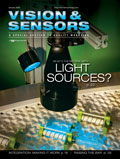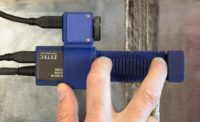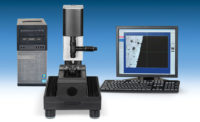
Different lighting sources will create shadows, illuminate the part under inspection and can help achieve a tighter tolerance for the application. What exactly should a manufacturer know to make an informed purchase of lighting for their machine vision application? To start, a manufacturing professional should understand the importance of light sources and what types of lighting are available for machine vision applications.

Manufacturers can choose a colored dome illumination light based on their applications and testing requirements. Source: Keyence Corp. of America
Why is it important?
First and foremost, say experts, manufacturing customers must be aware of the importance of lighting in their machine vision application.“Sometimes people think lighting is just an add-on at the end. They think, ‘We have our sensor and our lens and then there is lighting. Let’s just stick with something that is going to be cheap and we’ll be fine,’” relates Bruce Butkus, product line engineer for Edmund Optics (Barrington, NJ). “It’s important to emphasize the importance of all three parts together.”
Light sources interplay with the part being inspected and the camera taking the picture. The light will interact with each part in a different way, and by optimizing the type of light source used such as backlights versus ring lights, manufacturers can design a machine vision system that complements their application.
“Light sources are a key component to any vision application. The CCD [charge-coupled device] image element of a camera relies on light received in order to feed the image data back to the vision system,” says Joshua Jelonek, project manager-vision and marking technology for Keyence Corp. of America (Woodcliff Lake, NJ). “Without proper illumination, the vision system won’t work.”
Jelonek explains that different light sources give off various forms of contrast to an application as well-another key reason why choosing an appropriate light source is important. “You need your target to stand out from your background and you need light to do that,” he adds.

These backlights are built for a long lifecycle, chromaticity stability and luminance. They have a patented technology called light pipe, and are ideal for specialized applications such as glass inspection or other semi-transparent materials. Source: Leutron Vision Inc.
What is available?
Light emitting diodes (LEDs) are quickly becoming the norm for today’s machine vision applications. Better technology, decreasing costs and superior performance and lifespan have put LEDs at the forefront for many vision applications. But the improvement of LEDs oftentimes is still not appropriate for longer distance applications or applications where a large quantity of LEDs is needed. As manufacturers wait for LEDs to continue to improve even further over time, there are still many applications where older technologies such as fluorescents, halogens and fiber optics get the job done.“LEDs are great in an area where you are inspecting smaller objects or objects very close,” Butkus says. “At a longer distance, LEDs can be harder to illuminate and that’s just due to the technology.” Applications such as inspecting molds or chips on a circuit board could be appropriate for LEDs.
For a larger application, Jelonek says, such as a car door inspection three or four feet away, a halogen light source that can focus on the area brightly from that distance away would be more appropriate than an LED. “You would need a lot more LEDs to cover a large area, so they could become cost prohibitive,” he says.
Fluorescent lights also provide a high amount of brightness in a compact design and can help inspect anything from bottle caps on an assembly line to medical devices.
But one of the biggest differences between LEDs and other machine vision lighting sources is the lifespan. LEDs tend to have between five and 10 times the life expectancy of a fluorescent or halogen bulb.
“Life expectancy can end up making it a much more economical choice in a lot of cases because you don’t have to replace the light often,” says Jim Anderson, machine vision product manager at Sick Inc. (Minneapolis).
Much of the increased life expectancy of LED bulbs can be attributed to the strobe or triggering ability of an LED. The lifetime of a light source has a lot to do with the heat of the light. Choosing to strobe or trigger the light source can reduce the amount of heat generated.
“If you can strobe your light source-for example set up your application so that as the part comes by the light briefly flashes in tune with the camera-it will generate much less heat,” Jelonek explains. “You can’t do this very easily with other light sources as they need time to reach their optimum brightness when first turned on.”
“The trigger ability of LEDs is particularly [useful] for machine vision applications,” Butkus explains. “If you don’t need to see every frame but rather just as your products are coming by, it keeps the bandwidth of a camera down and data capturing to a minimum.” With strobe or triggering capability, a quality professional can “overdrive” the light, which means it temporarily provides more power-typically 110% to 120% of its normal output-for a short period of time. It provides a little more illumination than one would get if the light source were on continually.

Using a laser line triangulation light source with a 3-D smart camera, manufacturers can detect surface defects in brake pads. Source: Sick Inc.
What to know
1. Know the application.To choose an appropriate light source for a machine vision application, manufacturers should be aware of what exactly they are looking to inspect or test, what the environmental conditions of the workplace are, what the natural lighting conditions are, if any, and anything else that might affect the light source purchase. Operators should determine the goal of the application and tolerances, not only for the absolute good and bad parts, but also for marginal parts.
“The best thing that users can know is what about their part and what about their application is important. They need to clearly define their tolerance and what makes a part good or bad for their application,” Anderson says. Knowing where lights can be mounted as well as temperature conditions, for example, are vital to help the vendor design the best machine vision scenario for the application.
Knowledge of the application helps the manufacturer and the light source provider determine not only the appropriate type of lighting needed for the application, but the most appropriate colored light if necessary.
Stephane Francois, executive vice president of Leutron Vision Inc. (Burlington, MA), which sells Phlox lighting products, recommends manufacturers be versed in different types of lighting as well.
“It’s important to understand what backlighting is, and the different types of illumination techniques. Once you understand what’s available, you can select a product that will do the job,” he says. “If you understand the type of light you need, then the decision is fairly easy.”
Being aware of how the lighting interplays with the application or part will help a manufacturer understand how they will view, measure and inspect the image during the machine vision process.
“It’s very important to understand how the light interacts with your part and what exactly you are looking to measure or inspect on the part. This will determine how you will view your pictures,” Butkus explains.
2. Ask an expert.
Once the manufacturer is well-versed on the application and light sources available, experts suggest asking the vendor to help recommend the best light sources for the application.
“Sometimes it can be difficult to make the appropriate decision, so it’s important to take the time to speak with a vendor that has experience dealing with difficult machine vision applications,” Jelonek advises.
Choosing the appropriate light source for an application could mean paying a bit extra for an upgraded light, but saving thousands by not having to upgrade to a higher- resolution camera, Butkus adds.
3. Budget appropriately.
Lastly, and debatably most important, budgeting for light sources is extremely important to ensure the machine vision inspection process performs up to snuff.
“Sometimes I think people get a little sticker shock from seeing prices. Applications may call for specialized lights and they can be expensive, but it’s the key to making the machine vision application work,” Jelonek says.
“It is important not to overlook the lighting when estimating the cost of a project,” Anderson says. “You might not budget for it and then try to get away with a less expensive light to complete your solution. One can select the highest resolution camera, the best available imaging tools and yet fail to solve the application if the appropriate lighting was not picked.”
Manufacturers need to ensure that all aspects of their machine vision application get included in the budget-and, in many cases lighting completes the solution and makes the application possible. Manufacturers should be versed in the part they would like to inspect, as well as the tolerance they want to achieve and the lighting sources available to them before making a purchasing decision. V&S
Maggie McFadden is managing editor-new media/print.

Ring lights offer 360-degree illumination around the lens system and are widely used in many applications because of their ability to produce even, high-intensity lighting. Flat and diffuse surfaces are ideally illuminated with ring lights in bright-field configurations. Specular surfaces can be well illuminated with ring lights operating in a dark-field application. Source: Edmund Optics
Tech Tips
- By optimizing the type of light source used such as backlights versus ring lights, manufacturers can design a machine vision system that complements their application.- LEDs tend to have between five and 10 times the life expectancy of a fluorescent or halogen bulb.
- By strobing or triggering a light source, a quality professional can temporarily use more power-typically 110% to 120% of its normal output-providing a little more illumination than if the light source were on continually.
- Manufacturers should be aware of what exactly they are looking to inspect or test, what the environmental conditions of the workplace are, what the natural lighting conditions are, if any, and anything else that might affect the light source purchase.

